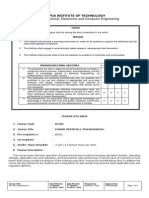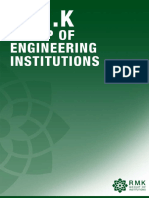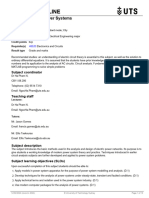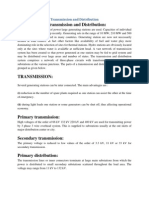0 ratings0% found this document useful (0 votes)
224 viewsModified Course File
This document describes two power system engineering courses. The first course titled "Power System Engineering" covers topics like transmission line parameters, performance evaluation of overhead lines, insulator design, underground cables, and substations. The second course titled "Power System Analysis" covers load flow analysis, economic operation, fault analysis, stability analysis, and distribution systems. Both courses aim to provide knowledge of power system components, modeling, performance evaluation, and problem solving skills.
Uploaded by
Zafar AhmadCopyright
© © All Rights Reserved
Available Formats
Download as DOCX, PDF, TXT or read online on Scribd
0 ratings0% found this document useful (0 votes)
224 viewsModified Course File
This document describes two power system engineering courses. The first course titled "Power System Engineering" covers topics like transmission line parameters, performance evaluation of overhead lines, insulator design, underground cables, and substations. The second course titled "Power System Analysis" covers load flow analysis, economic operation, fault analysis, stability analysis, and distribution systems. Both courses aim to provide knowledge of power system components, modeling, performance evaluation, and problem solving skills.
Uploaded by
Zafar AhmadCopyright
© © All Rights Reserved
Available Formats
Download as DOCX, PDF, TXT or read online on Scribd
You are on page 1/ 8
Course Title Power System Engineering
Course number EE-231N
Credit Value 4
Course Category DC
Pre-requisite Nil
Contact Hours (L-T-P) 3-1-0
Type of Course Theory
Course
Objectives
a. To give an overview of power system and its various components and their importance.
b. To calculate the line parameters of an over head power transmission line.
c. To evaluate line performance i.e. calculation of efficiency, voltage regulation and corona losses.
d. To understand the mechanical aspects of overhead transmission line.
e. To know various types of cables, their constructional features and current rating.
f. To know types of Sub-stations, its earthing various equipments used in them and their function.
Course
Outcomes
After completing the course, the students should be able to know about the overhead and underground
types of transmission systems, different mathematical models to represent different types of
transmission lines and evaluate their performance. They should also be able to design an overhead
transmission line including mechanical aspects. They will also know about different types of sub-
stations, sub-station earthing and different components used in it and their objective.
Syllabus UNIT I:
Electrical Characteristics of O.H. Lines: Types of conductors for O.H. power transmission. Calculation
of Line parameters; inductance and capacitance for single and double circuit lines, bundle conductors.
Concept of GMD and GMR, Effect of earth on line capacitanc
UNIT II:
Performance of O.H. Transmission Lines: Representation of short, medium and long transmission
lines; nominal-T, nominal- and equivalent-, Characteristic impedance, Z0 and SIL, ABCD
parameters, Voltage regulation and efficiency, Compensation of line, Corona and radio interference.
UNIT III:
Insulators and Mechanical Design of O.H. Lines: Types of insulators; pin, disc and strain type. Voltage
distribution and equalization; Arcing horns, Types of line supports, Air clearance. Sag calculations,
effect of wind and ice loading. Ground clearance, Vibration of conductors and dampers.
UNIT IV:
Underground Cables: Construction of single core and three core cables, electrostatic stresses and
grading of cables, thermal rating of cables, testing of cables, HVDC cables, cable failure.
UNIT V:
Substation: Classification, components and layout of substation (33 / 11 Kv). Package substations.
Introduction to Gas insulated substations, Substation grounding and grounding methods.
Books*/
Referencs
1. *Nagrath and Kothari Power System Engg. 3
rd
edition (TMH)
2. Cotton and Barbar Transmission and Distribution of Electrical Energy, (BI Publications).
3. Ashfaq Husain Electrical Power System; 4
th
edition (CBS).
4. WD Stevenson Elements of Power System Analysis (McGraw Hill).
5. CL WadhwaElectrical Power Systems (Wiley Eastern).
Course Assessment/
Evaluation/Grading
Policy
Sessional
Assignments (2) 15 Marks
Mid Term Examination (1Hour) 25 Marks
Sessional Total 40 Marks
End Semester Examination (3 Hours) 60 Marks
Total 100 Marks
PROGRAM EDUCATIONAL OBJECTIVES (PEOs)
PEO 1: Students will have a successful technical or professional careers, including supportive and leadership roles on
multidisciplinary teams.
PEO 2: Students will be able to acquire, use and develop skills as required for effective professional practices.
PEO 3: Students will be able to attain holistic education that is an essential prerequisite for being a responsible member of
society.
PEO 4: Students will be engaged in life-long learning, to remain abreast in their profession and be leaders in our
technologically vibrant society.
PROGRAM OUTCOMES (POs)
a) Students will demonstrate knowledge of mathematics, science and Electrical Engineering.
b) Students will demonstrate an ability to identify, formulate and solve Electrical engineering problems.
c) Students will demonstrate an ability to design electrical and electronic circuits and conduct experiments with electrical
systems, analyze and interpret data.
d) Students will demonstrate an ability to design a system, component or process as per needs and specification within
realistic constraints.
e) Students will demonstrate an ability to visualize and work on laboratory and multidisciplinary tasks.
f) Students will demonstrate skills to use modern engineering tools, software and equipment to analyze problems.
g) Students will demonstrate knowledge of professional and ethical responsibilities.
h) Students will be able to communicate effectively.
i) Students will show the understanding of impact of engineering solutions on the society and also will be aware of
contemporary issues.
j) Students will develop confidence for self-education and ability to engage in life-long learning.
k) Students who can participate and succeed in competitive examinations.
Mapping with POs:
POs a b c d e f g h i j k
x x x x x x x x
Course Title Power System Analysis
Course number EE-335N
Credit Value 4
Course Category DC
Pre-requisite Nil
Contact Hours (L-T-P) 3-1-0
Type of Course Theory
Course
Objectives
a. To understand various operational problems of a large power system.
b. To solve the load flow problem using different techniques.
c. To optimize the generation including transmission losses.
d. To analyze various types of faults faced by the system.
e. To analyze the system under large disturbance and mitigate the problem.
f. To understand the various types of distribution systems.
Course
Outcomes
At the end of the course the students will be able to:
1. solve load flow problems using per unit values systems.
2. develop power system network models.
3. formulate and solve load flow problems using various techniques as per the requirements of complexity,
computational time and accuracy.
4. calculate power losses in power system and develop economical power system operation scheme.
5. differentiate various types of fault and calculate the associated fault values for symmetrical and
unsymmetrical faults.
6. perform stability analysis and decide stability criteria as per a given problem.
7. differentiate various distribution systems.
Syllabus UNIT I
Load Flow Analysis: Per unit system of calculation, Formation of network model Y
BUS
by inspection and by
singular transformation, Formulation of load flow problem; type of buses, Solution techniques Gauss-Seidel
and Newton Raphson. Representation of voltage controlled buses and transformers. Decoupled and fast-
decoupled load flow.
UNIT II
Economic Operation of Power Systems: Study of economic dispatch problem in a thermal power station,
consideration of transmission losses in economic dispatch, simplified method of loss-formula calculation,
solution of coordination equation, unit commitment, Introduction to load frequency and voltage control.
UNIT III
Fault Analysis: Types of fault, calculation of fault current and voltages for symmetrical short circuit.
Symmetrical components, Sequence impedance and networks of power system elements, unsymmetrical short
circuits and series fault, Current limiting reactors.
UNIT IV
Stability Analysis: Introduction to steady state and transient stability of power systems, swing equation, equal
area criteria, solution of swing equation, methods of improving stability, Introduction to voltage stability.
UNIT V
Distribution Systems: Different types of distribution systems. Distributors fed from one end and both ends, ring
mains, unbalanced loading, Rural electrification.
Books*/
References
1. *Nagrath and Kothari, Power System Analysis, 3
rd
edition (TMH).
2. BR Gupta, Power System Analysis and Design.
3. Grainger and Stevenson, Power System Analysis (McGraw Hill).
4. Hadi Saadat, Power System Analysis, (TMH).
Course
Assessment/
Evaluation/Grad
ing Policy
Sessional
Assignments (2 ) 15 Marks
Mid Term Examination (I Hour) 25 Marks
Sessional Total 40 Marks
End Semester Examination (3 Hours) 60 Marks
Total 100 Marks
PROGRAM EDUCATIONAL OBJECTIVES (PEOs)
PEO 1: Students will have a successful technical or professional careers, including supportive and leadership roles on
multidisciplinary teams.
PEO 2: Students will be able to acquire, use and develop skills as required for effective professional practices.
PEO 3: Students will be able to attain holistic education that is an essential prerequisite for being a responsible member of
society.
PEO 4: Students will be engaged in life-long learning, to remain abreast in their profession and be leaders in our
technologically vibrant society.
PROGRAM OUTCOMES (POs)
a. Students will demonstrate knowledge of mathematics, science and Electrical Engineering.
b. Students will demonstrate an ability to identify, formulate and solve Electrical engineering problems.
c. Students will demonstrate an ability to design electrical and electronic circuits and conduct experiments with electrical
systems, analyze and interpret data.
d. Students will demonstrate an ability to design a system, component or process as per needs and specification within
realistic constraints.
e. Students will demonstrate an ability to visualize and work on laboratory and multidisciplinary tasks.
f. Students will demonstrate skills to use modern engineering tools, software and equipment to analyze problems.
g. Students will demonstrate knowledge of professional and ethical responsibilities.
h. Students will be able to communicate effectively.
i. Students will show the understanding of impact of engineering solutions on the society and also will be aware of
contemporary issues.
j. Students will develop confidence for self-education and ability to engage in life-long learning.
k. Students who can participate and succeed in competitive examinations.
Mapping with POs:
POs a b c d e f g h i j k
x x x x x x x x
Course Title Electrical Power Generation and Utilization
Course number EE-331
Credit Value 4
Course Category DC
Pre-requisite Nil
Contact Hours (L-T-P) 3-1-0
Type of Course Theory
Course
Objectives
a. To introduce the fundamentals of illumination engineering.
b. To know about various types of batteries and their field of applications.
c. To know about electro-plating and composition of bath for different plating.
d. To know about the Railway electrification, various types of services and their characteristics.
e. To know various types of conventional power plants and their suitability criterion, site selection, maintenance
and operation.
Course
Outcomes
At the end of the course the students will be able to
1. Have the knowledge of various types of conventional power plants and their working ,different equipments and
instruments used for trouble free operation and maintenance ,and factors to be considered for proper site selection
2. Know about various types of lamps their working principle, construction, field of application.
3. Design the lighting system for various applications.
4. Various types of storage batteries and their field of applications.
5. Electro-plating and its applications and composition of electroplating baths.
6. Different types of traction systems particularly electric traction system, types of services and their characteristics,
overhead line equipments and maintenance of line.
Syllabus UNIT I: Thermal Power Plants:
Coal fired Plants: Site selection, various components, parts and their operation, Steam and fuel
cycles, Pollution control, Modern clean coal Technologies.
Nuclear Power Plants: Site Selection, Principal of Fission, Main components of nuclear reactor, Fast
Breeder and other reactors, Fuel extraction, enrichment and fabrication, Basic control of reactors,
Environmental aspects.
UNIT II: Hydro and Gas Power Plants:
Hydro Plants: Site selection, Classification of Hydro plants, Main components and their functions,
Classification of turbines, Pumped storage plants, Environmental aspects.
Gas Turbine plant: Principle of operation, Open& closed cycle plants, Combined cycle plants,
IGCC.
UNIT III: Cogeneration and Captive Power Plants:
Scope & Benefits Cogeneration Plants, Cogeneration Technologies, Scope & Benefits of Captive
Plants (CPP), Types of CPP, Concept of Distributed Generation.
UNIT IV: Electric Traction:
Speed time curves, Tractive efforts and specific energy consumptions, Track electrification &
traction substations, Current collectors, Negative boosters and control of traction motors.
UNIT V: Illumination and Electrolytic Effects:
Illumination: Definitions, Laws of illuminations, Principle of operation & construction of various
lamps, Various aspects of illumination design, design examples with different lamps.
Electrolytic Effects: Types of Batteries, their components, Charging & maintenance, Tubular
batteries. Electroplating and its applications.
Books*/
References
1. *B.R.Gupta, Generation of Electrical Energy (Eurasia Pub. House).
2. S.N.Singh, Electric Power Generation, Transmission & Distribution (PHI).
3. M.V.Deshpande, Elements of Electrical Power Station Design (Wheeler Pub. House).
4. *H.Pratab, Art & Science of Utilization of Electrical Energy (Dhanpat Rai & sons).
5. C.L.Wadhwa, Generation, Transmission & Distribution of Electrical Energy(Wiley Eastern Pub).
6. N.V.Suryanarayana, Utilization of Electric Power (Wiley Eastern Pub.).
Course
Assessment/
Evaluation/
Grading
Policy
Sessional
Assignments (2) 15 Marks
Mid Term Examination (I Hour) 25 Marks
Sessional Total 40 Marks
End Semester Examination (3 Hours) 60 Marks
Total 100 Marks
PROGRAM EDUCATIONAL OBJECTIVES (PEOs)
PEO 1: Students will have a successful technical or professional careers, including supportive and leadership roles on
multidisciplinary teams.
PEO 2: Students will be able to acquire, use and develop skills as required for effective professional practices.
PEO 3: Students will be able to attain holistic education that is an essential prerequisite for being a responsible member of
society.
PEO 4: Students will be engaged in life-long learning, to remain abreast in their profession and be leaders in our
technologically vibrant society.
PROGRAM OUTCOMES (POs)
a. Students will demonstrate knowledge of mathematics, science and Electrical Engineering.
b. Students will demonstrate an ability to identify, formulate and solve Electrical engineering problems.
c. Students will demonstrate an ability to design electrical and electronic circuits and conduct experiments with electrical
systems, analyze and interpret data.
d. Students will demonstrate an ability to design a system, component or process as per needs and specification within
realistic constraints.
e. Students will demonstrate an ability to visualize and work on laboratory and multidisciplinary tasks.
f. Students will demonstrate skills to use modern engineering tools, software and equipment to analyze problems.
g. Students will demonstrate knowledge of professional and ethical responsibilities.
h. Students will be able to communicate effectively.
i. Students will show the understanding of impact of engineering solutions on the society and also will be aware of
contemporary issues.
j. Students will develop confidence for self-education and ability to engage in life-long learning.
k. Students who can participate and succeed in competitive examinations.
Mapping with POs:
POs a b c d e f g h i j k
x x x x x x x
Course Title Power Station Practice
Course number EE-435
Credit Value 4
Course Category DE
Pre-requisite Power System Analysis
Contact Hours (L-T-P) 3-1-0
Type of Course Theory
Course
Objectives
a. To know different types of curves used in power plants and cost calculations.
b. To know the various types of tariff system to charge a costumer.
c. To know the co-ordination between conventional power plants.
d. To know various instruments/equipments used in power stations.
e. Know about EHV substations.
Course
Outcomes
At the end of the course the students will be able to
1. Analyze the problem of economics in power system
2. Apply design of various new technologies to optimize the economical relations.
3. Formulate and solve coordination problem of power system plants.
Syllabus UNIT-1: Economics of Generation
Types of loads, demand factor, group diversity factor and peak diversity factor, load curve, load duration curve,
load factor, capacity factor and utilization factor, base load and peak load stations, operating and spinning
reserves, load forecasting, capital cost of power plants. Depreciation.Annual fixed and operating charges.
UNIT- 2: Tariff and Power Factor Improvement
General tariff form and different types of tariffs, Tariff option for DSM. Causes and effect of low power factor,
necessity of improvement and use of power factor improvement devices.
UNIT-3: Coordinated Operation of Power Plants
Advantages of Coordinated operation of different types of power plants, hydrothermal scheduling: short term and
long term. Coordination of various types of power plant.
UNIT-4: Electrical Equipments in Power Plants
Governors for hydro and thermal generators, excitation systems; exciters and automatic voltage regulators (AVR),
bus bar arrangements.
UNIT-5: EHV Substation
Layout of EHV substation, brief description of various equipments used in EHV substations, testing and
maintenance of EHV substations equipments. Gas insulated substations (GIS).
Books*/
References
1. *B.R. Gupta, Generation of Electrical Energy, (Euresia Publishing House).
2. M.V. Deshpande, Elements of Electrical Power Station Design, (Wheeler Publishing House).
3. S. Rao, Electrical Substation-Engineering and Practice, (Khanna).
4. S.N. Singh, Electric Power Generation, Transmission and Distribution (PHI).
Course
Assessment/
Evaluation/Grad
ing Policy
Sessional
Assignments (2) 15 Marks
Mid Term Examination (I Hour) 25 Marks
Sessional Total 40 Marks
End Semester Examination (3 Hours) 60 Marks
Total 100 Marks
PROGRAM EDUCATIONAL OBJECTIVES (PEOs)
PEO 1: Students will have a successful technical or professional careers, including supportive and leadership roles on
multidisciplinary teams.
PEO 2: Students will be able to acquire, use and develop skills as required for effective professional practices.
PEO 3: Students will be able to attain holistic education that is an essential prerequisite for being a responsible member of
society.
PEO 4: Students will be engaged in life-long learning, to remain abreast in their profession and be leaders in our
technologically vibrant society.
PROGRAM OUTCOMES (POs)
a. Students will demonstrate knowledge of mathematics, science and Electrical Engineering.
b. Students will demonstrate an ability to identify, formulate and solve Electrical engineering problems.
c. Students will demonstrate an ability to design electrical and electronic circuits and conduct experiments with electrical
systems, analyze and interpret data.
d. Students will demonstrate an ability to design a system, component or process as per needs and specification within
realistic constraints.
e. Students will demonstrate an ability to visualize and work on laboratory and multidisciplinary tasks.
f. Students will demonstrate skills to use modern engineering tools, software and equipment to analyze problems.
g. Students will demonstrate knowledge of professional and ethical responsibilities.
h. Students will be able to communicate effectively.
i. Students will show the understanding of impact of engineering solutions on the society and also will be aware of
contemporary issues.
j. Students will develop confidence for self-education and ability to engage in life-long learning.
k. Students who can participate and succeed in competitive examinations.
Mapping with POs:
POs a b c d e f g h i j k
x x x x x x x
You might also like
- Guide For Transmission Line Subsidence PDF100% (1)Guide For Transmission Line Subsidence PDF17 pages
- Construction Manual For Transmission Lines95% (59)Construction Manual For Transmission Lines122 pages
- S310 Serise: 200V Class 0.4 1.5KW (0.88 2.9KVA)No ratings yetS310 Serise: 200V Class 0.4 1.5KW (0.88 2.9KVA)71 pages
- Revised Syllabus TY Electrical AY 2020 21 Modified 2020 04.08.2020No ratings yetRevised Syllabus TY Electrical AY 2020 21 Modified 2020 04.08.202035 pages
- BEEE304L_POWER-SYSTEMS-ENGINEERING_TH_1.0_67_Power Systems EngineeringNo ratings yetBEEE304L_POWER-SYSTEMS-ENGINEERING_TH_1.0_67_Power Systems Engineering3 pages
- Course Outline - 1136098903introduction To Power Systems Course OutlineNo ratings yetCourse Outline - 1136098903introduction To Power Systems Course Outline2 pages
- Course Syllabus: United International UniversityNo ratings yetCourse Syllabus: United International University6 pages
- Mtech Pse Revised Syllabus 02 08 2016 0535pmNo ratings yetMtech Pse Revised Syllabus 02 08 2016 0535pm42 pages
- P.R.Surya A.P/Eee: Dindigul - Palani Highway, Dindigul-624 002No ratings yetP.R.Surya A.P/Eee: Dindigul - Palani Highway, Dindigul-624 0025 pages
- EE43955390 PowerSysAnalysis Syllabus Fall2021 v3-2No ratings yetEE43955390 PowerSysAnalysis Syllabus Fall2021 v3-27 pages
- ELEN3001 Power System Analysis Semester 1 2016 Bentley Campus INTNo ratings yetELEN3001 Power System Analysis Semester 1 2016 Bentley Campus INT8 pages
- B.E. (E & E) V-Vi Semester 2017-18: Size: Demy 1/8 / 52 Pages / 80 GSM Maplitho / Qty. 100 Book - Black InkNo ratings yetB.E. (E & E) V-Vi Semester 2017-18: Size: Demy 1/8 / 52 Pages / 80 GSM Maplitho / Qty. 100 Book - Black Ink26 pages
- MRSPTU B.Tech. Electrical 5th Sem Scheme and Syllabus 2018 Batch OnwardsNo ratings yetMRSPTU B.Tech. Electrical 5th Sem Scheme and Syllabus 2018 Batch Onwards17 pages
- EE 353-Electrical Power Systems-Farhan MahmoodNo ratings yetEE 353-Electrical Power Systems-Farhan Mahmood5 pages
- Course File (Course Plan) Year: July2013-Dec.2013 Sem: 5thNo ratings yetCourse File (Course Plan) Year: July2013-Dec.2013 Sem: 5th25 pages
- Distribution of Electrical Power: Lecture Notes of Distribution of Electrical Power CourseFrom EverandDistribution of Electrical Power: Lecture Notes of Distribution of Electrical Power CourseNo ratings yet
- Mechanical Vibration and Oscillation in Transmission Lines: Supervised By: Mr. Niraj Chaudhary Electrical Engg. DeptNo ratings yetMechanical Vibration and Oscillation in Transmission Lines: Supervised By: Mr. Niraj Chaudhary Electrical Engg. Dept27 pages
- PANJ20 Site Electrification Acceptance Testing Checksheet V1.0 R00 27072021No ratings yetPANJ20 Site Electrification Acceptance Testing Checksheet V1.0 R00 2707202111 pages
- CIGRE Innovative Inspection Techniques and Digital Tools For Condition Follow-Up of OHLS in BelgiumNo ratings yetCIGRE Innovative Inspection Techniques and Digital Tools For Condition Follow-Up of OHLS in Belgium15 pages
- Chap 6 - High Voltage Testing of Equipment100% (1)Chap 6 - High Voltage Testing of Equipment16 pages
- JASTHAN RAJYA VIDYUT Construction Manual For Lines11A 2de236 - 8934 - RoNo ratings yetJASTHAN RAJYA VIDYUT Construction Manual For Lines11A 2de236 - 8934 - Ro120 pages
- Investigation Into Tower Model Effect On Fast-Front Overvoltages in Transmission LinesNo ratings yetInvestigation Into Tower Model Effect On Fast-Front Overvoltages in Transmission Lines6 pages
- VSE-DB0104-0806 Surge Suppressor Capacitors - INTERACTIVE PDFNo ratings yetVSE-DB0104-0806 Surge Suppressor Capacitors - INTERACTIVE PDF21 pages
- Computation of Electric Field Distribution Near EHV UHV TransmissionNo ratings yetComputation of Electric Field Distribution Near EHV UHV Transmission6 pages
- Objective Type Question of Transmission and Distributio1No ratings yetObjective Type Question of Transmission and Distributio124 pages
- Question Bank Technical Helper (Distribution) : Sector: Power Reference ID: PSS/ Q 0101No ratings yetQuestion Bank Technical Helper (Distribution) : Sector: Power Reference ID: PSS/ Q 010138 pages
- BS 6485-1999 PVC Covered Overhead ConductorNo ratings yetBS 6485-1999 PVC Covered Overhead Conductor12 pages
- Revised Syllabus TY Electrical AY 2020 21 Modified 2020 04.08.2020Revised Syllabus TY Electrical AY 2020 21 Modified 2020 04.08.2020
- BEEE304L_POWER-SYSTEMS-ENGINEERING_TH_1.0_67_Power Systems EngineeringBEEE304L_POWER-SYSTEMS-ENGINEERING_TH_1.0_67_Power Systems Engineering
- Course Outline - 1136098903introduction To Power Systems Course OutlineCourse Outline - 1136098903introduction To Power Systems Course Outline
- P.R.Surya A.P/Eee: Dindigul - Palani Highway, Dindigul-624 002P.R.Surya A.P/Eee: Dindigul - Palani Highway, Dindigul-624 002
- EE43955390 PowerSysAnalysis Syllabus Fall2021 v3-2EE43955390 PowerSysAnalysis Syllabus Fall2021 v3-2
- ELEN3001 Power System Analysis Semester 1 2016 Bentley Campus INTELEN3001 Power System Analysis Semester 1 2016 Bentley Campus INT
- B.E. (E & E) V-Vi Semester 2017-18: Size: Demy 1/8 / 52 Pages / 80 GSM Maplitho / Qty. 100 Book - Black InkB.E. (E & E) V-Vi Semester 2017-18: Size: Demy 1/8 / 52 Pages / 80 GSM Maplitho / Qty. 100 Book - Black Ink
- MRSPTU B.Tech. Electrical 5th Sem Scheme and Syllabus 2018 Batch OnwardsMRSPTU B.Tech. Electrical 5th Sem Scheme and Syllabus 2018 Batch Onwards
- Course File (Course Plan) Year: July2013-Dec.2013 Sem: 5thCourse File (Course Plan) Year: July2013-Dec.2013 Sem: 5th
- Distribution of Electrical Power: Lecture Notes of Distribution of Electrical Power CourseFrom EverandDistribution of Electrical Power: Lecture Notes of Distribution of Electrical Power Course
- Mechanical Vibration and Oscillation in Transmission Lines: Supervised By: Mr. Niraj Chaudhary Electrical Engg. DeptMechanical Vibration and Oscillation in Transmission Lines: Supervised By: Mr. Niraj Chaudhary Electrical Engg. Dept
- PANJ20 Site Electrification Acceptance Testing Checksheet V1.0 R00 27072021PANJ20 Site Electrification Acceptance Testing Checksheet V1.0 R00 27072021
- CIGRE Innovative Inspection Techniques and Digital Tools For Condition Follow-Up of OHLS in BelgiumCIGRE Innovative Inspection Techniques and Digital Tools For Condition Follow-Up of OHLS in Belgium
- JASTHAN RAJYA VIDYUT Construction Manual For Lines11A 2de236 - 8934 - RoJASTHAN RAJYA VIDYUT Construction Manual For Lines11A 2de236 - 8934 - Ro
- Investigation Into Tower Model Effect On Fast-Front Overvoltages in Transmission LinesInvestigation Into Tower Model Effect On Fast-Front Overvoltages in Transmission Lines
- VSE-DB0104-0806 Surge Suppressor Capacitors - INTERACTIVE PDFVSE-DB0104-0806 Surge Suppressor Capacitors - INTERACTIVE PDF
- Computation of Electric Field Distribution Near EHV UHV TransmissionComputation of Electric Field Distribution Near EHV UHV Transmission
- Objective Type Question of Transmission and Distributio1Objective Type Question of Transmission and Distributio1
- Question Bank Technical Helper (Distribution) : Sector: Power Reference ID: PSS/ Q 0101Question Bank Technical Helper (Distribution) : Sector: Power Reference ID: PSS/ Q 0101

























































































